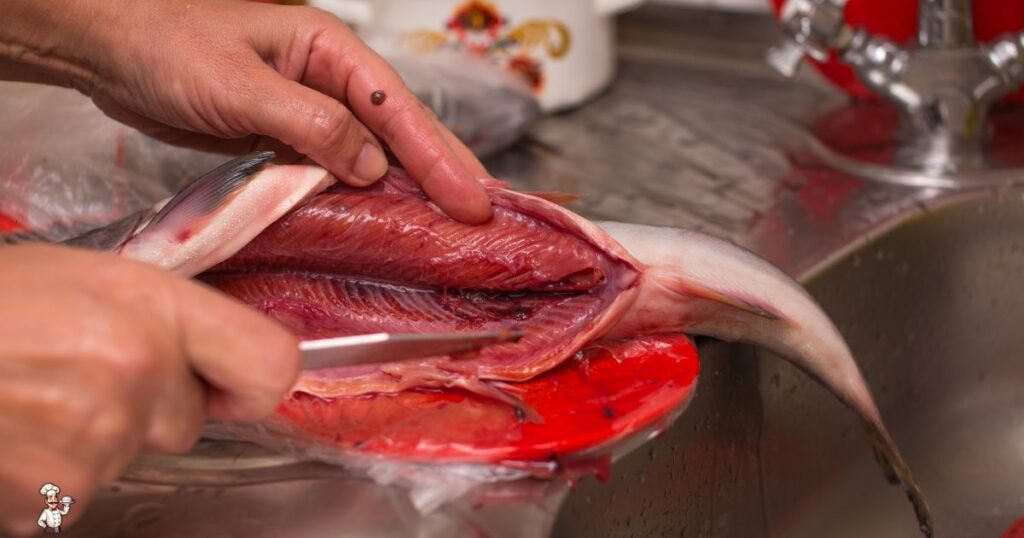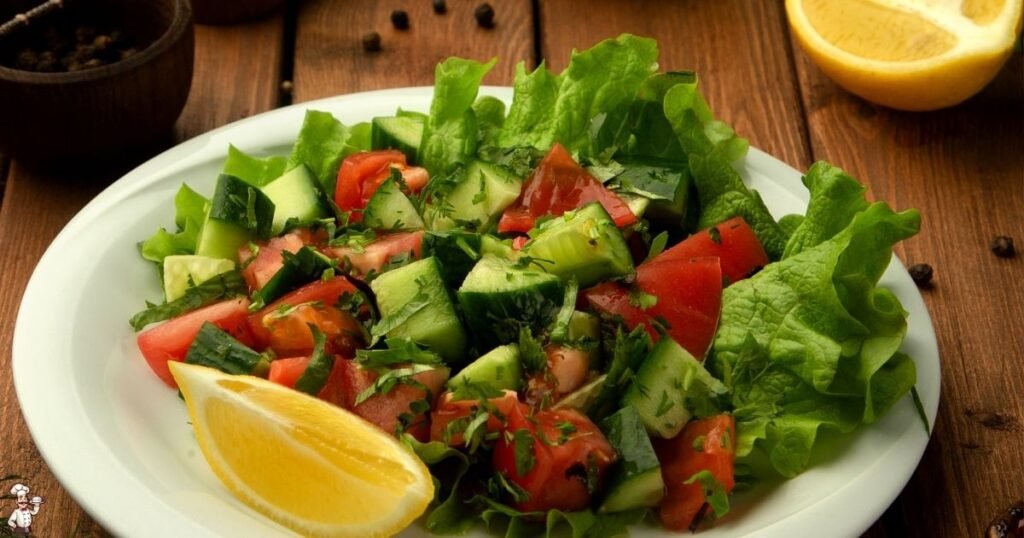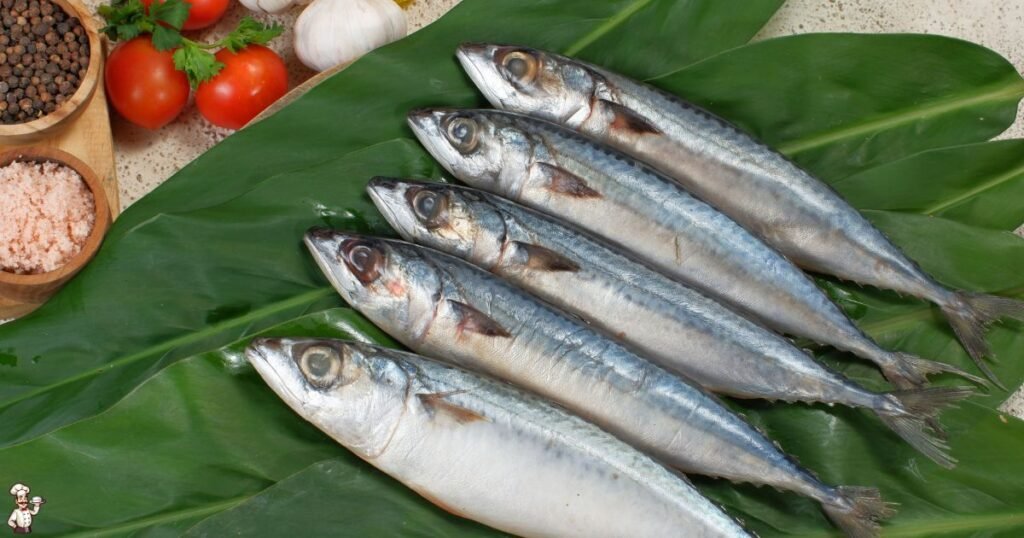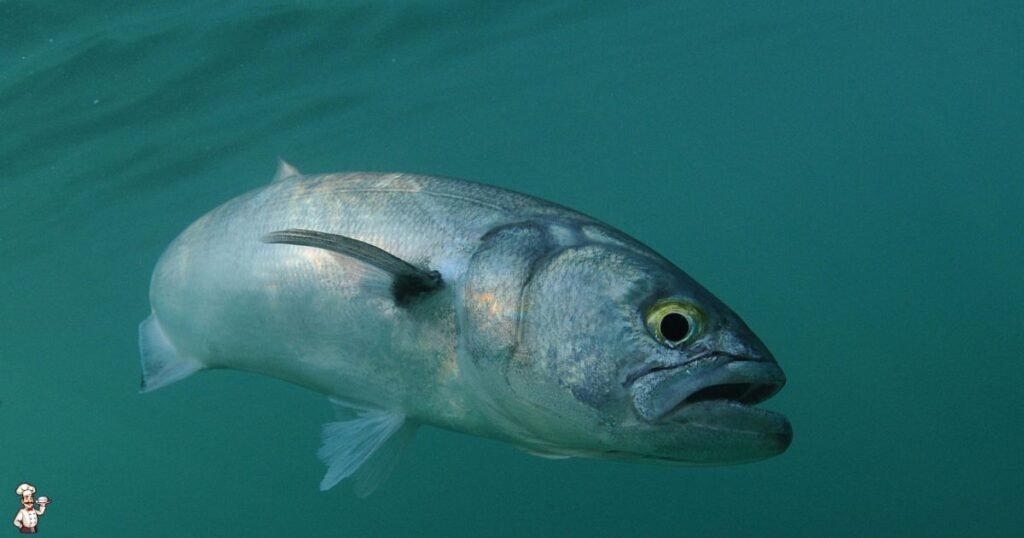In this blog post, we will explore how Turks eat fish with two authentic Turkish fish menus, each offering a unique skewer style or a hearty meal with vegetables. Turkish seafood is deeply rooted in culinary traditions, where every dish is carefully paired with traditional side dishes to highlight the rich flavors of Turkish cuisine.If you enjoy skewered foods, you might want to try our Easy Sis Tavuk Recipe: How to Make Turkish Chicken Skewers.”
Whether grilled over charcoal or cooked in a flavorful stew, the taste of fresh seafood reflects Turkey’s deep love for coastal flavors. These menus not only preserve age-old techniques but also showcase the vibrant and diverse way Turks eat fish today.
Turkish Fish Menu Video
First Course: Sardines and Vegetables Baked in a Guvech Pot
One of the most traditional ways to prepare fresh sardines in Turkey is using the guvech or kiremit, a clay pot that locks in flavor and moisture. This method allows the fish to be cooked gently while absorbing the natural juices of the vegetables, creating a dish that is both rich and comforting. If you like savory, hearty meals, check out our Turkish Chicken Rice (Tavuk Kapama): A One-Pot Classic.”
Essential Ingredients:
- Fresh sardines, can be deboned or left with bones if preferred
- 2 medium potatoes, cut into wedges for a hearty texture
- 1 onion, sliced thinly to enhance the dish’s aroma
- 2 tomatoes, diced to add natural sweetness and juiciness
- 1 green pepper, sliced for a mild heat and color
- Olive oil, a key element for rich Mediterranean flavor
- Paprika, pul biber (red pepper flakes), black pepper, oregano for seasoning
- Thinly sliced lemon wedges as a refreshing garnish
Preparation Steps:
Sauté the Vegetables:
To bring out the best flavors, sauté the onions, potatoes, and tomatoes in a pan until they soften slightly. This important step ensures they will cook evenly with the sardines, allowing all the ingredients to blend beautifully. The gentle frying process enhances their sweetness and texture, making the dish even more flavorful.
Optional: Debone the Sardines:
To prepare the sardines, you can gently remove the bones by peeling them from the middle. This step is optional, as some prefer to cook them whole and take out the bones while eating. Keeping the bones adds extra flavor, but deboning makes them easier to enjoy.

Season and Layer:
To enhance the taste, season the sardines with olive oil, paprika, pul biber, black pepper, and oregano. Then, carefully arrange them in the guvech pot, alternating layers of potato wedges, sautéed vegetables, and sliced green peppers. This layering method ensures every bite is packed with rich flavors and a perfect balance of textures.
Bake to Perfection:
Preheat the oven or air fryer to 180°C (356°F) for an even cook. Arrange the seasoned meatballs on a tray, adding potatoes for extra flavor. Bake for 20-25 minutes until golden brown and soft inside. Unlike sardines, these meatballs retain their juicy texture while being cooked through perfectly.
Garnish and Serve:
Once the dish is ready, garnish it with fresh lemon wedges to bring out the flavors. Turks serve their fish hot, often pairing it with a side of traditional Tarhana Soup and refreshing Shepherd Salad to create a well-balanced meal.
Safety Tip:
When using an air fryer for your fish dish, be careful with baking paper in a guvech pot. The airflow can cause it to lift dangerously, which may ruin your meal. If covering is needed, avoid paper and use aluminum foil instead for safe and even cooking.
Traditional Side Dishes:
A bowl of Tarhana is a must alongside a seafood feast, bringing a traditional and comforting touch to the meal. This Turkish soup is made from a mix of vegetables, herbs, and grains, creating a fermented flavor that deepens over time. The process starts with kneading a dough using fresh ingredients like tomatoes, peppers, and onions, then fermenting it for 10 to 15 days. Once dried, it is ground into a powder, allowing it to be stored properly for up to a year. Different versions of this dish exist across Anatolia, with some adding extra grains or even milk, making it a versatile and flavorful addition to any meal.If you’re looking for a comforting, filling meal, try our Easy Turkish Bulgur Pilaf with Chicken (Muhallebi).”
Turkish Shepherd’s Salad:
A traditional Turkish salad, known as Çoban Salatası, is a light and refreshing dish that is easy to prepare. It features fresh, seasonal vegetables that are finely chopped and dressed with olive oil and lemon juice. This healthy, stand-alone dish pairs wonderfully as a side dish with grilled meats, adding a burst of vibrant flavors to any meal.

Second Course: Sardine Skewers Paired with Cornbread
This menu brings a fresh twist to seafood, as it introduces not just one but two unique skewer styles that enhance the flavors of the sea. The sardines, expertly grilled, are paired with homemade cornbread, creating a delightful way to enjoy sardines in a crispy yet tender bite.
Cornbread Preparation:
- Mix 1/3 cup yogurt, vegetable oil, and milk in a bowl.
- Add 1 tbsp sugar, 1 tsp salt, and 2 tsp baking powder for flavor.
- Stir in 1 cup cornmeal and 2 tbsp cornmeal for texture.
- Sift 1/3 cup flour into the mixture for a smooth consistency.
- Crack 1 egg and whisk it well into the batter.
- Pour the batter into a greased pan for even baking.
- Bake until golden brown, ensuring a soft yet firm texture.For another delicious, easy-to-make bread recipe, check out our Ultimate Guide to Homemade Sourdough Bread.”
- Serve warm with fresh fish to enjoy an authentic Turkish meal.
| Ingredient | Quantity |
| Yogurt | 1/3 cup |
| Vegetable oil | 1/3 cup |
| Milk | 1/3 cup |
| Sugar | 1 tablespoon |
| Salt | 1 teaspoon |
| Baking powder | 2 teaspoons |
| Cornmeal | 1 cup + 2 tbsp |
| Flour | 1/3 cup |
| Egg | 1 large |
Cornmeal Bread:
Mix Ingredients:
To make the perfect cornbread to pair with Turkish fish dishes, take a bowl and combine yogurt, oil, and milk for a smooth base. Add a touch of sugar and salt to balance the flavors, then mix in baking powder for a light texture. Gently add an egg and whisk everything together until it forms a silky batter, ensuring the perfect consistency for baking.

Add Dry Ingredients:
To create the perfect texture, gradually add the cornmeal and flour, making sure to keep mixing as you go. This step helps the mixture reach a thick batter that holds its consistency, ensuring a well-balanced taste and a soft yet firm texture when baked.
Bake:
To complement a delicious fish meal, Turks love a freshly baked cornbread that is both crispy and soft inside. First, they pour the well-mixed batter into a greased pan to ensure it doesn’t stick. Then, it’s time to bake at 165°C (329°F) for about 20 minutes until the crust turns a beautiful golden color and the inside is fully cooked through. The result is a warm, flavorful side that pairs wonderfully with seafood, making every bite more satisfying.
Preparing the Sardine Skewers:
Clean and Season Sardines:
To make the best Turkish-style sardines, start by carefully deboning the fresh sardines to remove any tiny bones. This step ensures a smooth texture and better flavor absorption. Once cleaned, lightly season them with a pinch of salt and a dash of black pepper. This simple yet classic preparation brings out the rich, natural taste of the fish while keeping it fresh and delicious.
Two Skewer Variations:
Grape Leaf-Wrapped Sardines:
To make this dish special, sardines are carefully folded and wrapped in grape leaves. This method adds a unique touch, bringing out a rich flavor while keeping the fish incredibly juicy. The leaves act as a natural shield, ensuring the fish stays moist and tender as it cooks.

Classic Shish Kebab Style:
A traditional way to enjoy seafood in Turkey is by making skewers with sardines, green peppers, and tomatoes. The key is to alternate the ingredients, ensuring a balanced mix of flavors in every bite. Grilled over an open flame, this method enhances the natural taste of the fish while adding a smoky touch.
Grilling Instructions:
To get the best taste, heat a cast iron griddle and brush it with oil to prevent sticking. Place the sardines on skewers and carefully grill them until they turn golden and are fully cooked through. The smoky aroma and crispy edges make this dish a favorite along the Turkish coast, where fresh seafood is always the star.
Serving Suggestions:
To experience Turkish cuisine, try grilled sardine skewers paired with a fresh arugula and onion salad. Start by cleaning the sardines, removing their heads and bones, then lightly season them with salt and black pepper. Next, fold each sardine and wrap it in grape leaves, which adds a unique flavor and keeps the fish juicy. For a delightful twist, alternate the wrapped sardines with green peppers and tomatoes on skewers.
Preheat a cast iron griddle until hot, lightly oil the surface, and cook the sardine skewers until they achieve a golden hue and are thoroughly cooked. To complete the dish, pair the sardine skewers with a fresh arugula and onion salad. Mix arugula, purslane, tomatoes, green peppers, and onions with olive oil, lemon juice, salt, and sumac.
. Top with olives for an extra touch. This combination offers a harmonious blend of flavors and textures, showcasing the essence of Turkish seafood cuisine.

Traditional Dessert: Tahini Halva
In Turkish cuisine, sardines are often threaded onto skewers, alternating with green peppers and tomatoes, creating a vibrant and flavorful dish. To prepare, heat a cast iron griddle, brush it with oil, and grill the skewers until the sardines turn golden and are thoroughly cooked. Serving these sardine skewers alongside a fresh Arugula Onion Salad enhances the meal. Simply combine arugula, purslane, tomatoes, green peppers, and onions; dress with olive oil, lemon juice, salt, and sumac; and top with olives for an extra touch.
Street Food Highlight: Balık Ekmek – The Iconic Fish Sandwich
In Istanbul’s bustling districts like Eminönü, Balık Ekmek, meaning “fish in bread,” is a beloved street food. This sandwich features grilled mackerel fillets nestled in fresh bread, accompanied by lettuce, onions, and a squeeze of lemon. It’s a quintessential Turkish experience that showcases the nation’s love for simple yet flavorful seafood dishes.For another great street food recipe, try our Quick and Easy Lahmacun Recipe.”
Lüfer: The Prized Bluefish
Lüfer, or bluefish, holds a special place in Turkish cuisine, especially in the Bosphorus region. Known for its tender and flavorful meat, it’s typically grilled and served whole, garnished with lemon and fresh herbs. The fishing season for lüfer is celebrated with festivals, highlighting its cultural significance and the anticipation of its arrival in local markets.

Hamsi: Anchovies of the Black Sea
In the Black Sea region, hamsi (anchovies) are more than just a fish; they’re a cultural emblem. These small fish are prepared in various ways, from Hamsi Tava (pan-fried anchovies) to Hamsili Pilav (anchovy pilaf). Their rich flavor and versatility make them a staple during the fishing season, drawing both locals and tourists to coastal towns to savor these delicacies.You might also enjoy our Rolled Spinach Borek: The Ultimate Comfort Food You Need to Try.”
Midye Dolma: Stuffed Mussels
A popular seafood meze along Turkey’s coastlines is Midye Dolma, comprising mussels stuffed with spicy rice. This savory treat is enjoyed by both locals and tourists, offering a burst of flavors that reflect Turkey’s rich culinary heritage.
Frequently ask questions?
What are some traditional methods Turks use to prepare fish?
Turks commonly grill, fry, or poach fish. For example, sardines are often grilled on skewers or baked in a clay pot with vegetables.
What is ‘Balık Ekmek’?
‘Balık Ekmek’ translates to ‘fish in bread’ and is a popular Turkish street food, especially in Istanbul’s coastal districts. It consists of grilled fish, typically mackerel, served in bread with tomatoes, herbs, and onions.
Which fish are commonly used in Turkish cuisine?
Common fish include anchovy (hamsi), sardine (sardalya), bonito, gilt-head bream (çupra), red mullet (barbun), sea bass (levrek), and bluefish (lüfer).
What is ‘Hamsili Pilav’?
‘Hamsili Pilav’ is a traditional Turkish dish from the Black Sea region, made by baking rice and anchovies together, often seasoned with herbs and spices.
How do Turks typically serve grilled fish?
Grilled fish is often served with fresh vegetables, such as arugula and onions, and a drizzle of olive oil and lemon juice.
What is ‘Midye Dolma’?
‘Midye Dolma’ refers to mussels stuffed with spiced rice, a popular seafood meze along Turkey’s coastlines.
Are there regional variations in Turkish fish dishes?
Yes, for example, in the Black Sea region, anchovies (hamsi) are a staple and are prepared in various ways, such as frying or baking with rice.
What is ‘Tarhana Soup’ and its significance in a fish meal?
‘Tarhana Soup’ is a traditional Turkish soup made from a fermented mixture of vegetables, herbs, and grains. It is often served alongside fish dishes to complement the flavors.
How do Turks incorporate vegetables into their fish dishes?
Vegetables like tomatoes, green peppers, and potatoes are commonly cooked with fish, either baked together in a clay pot or served as side dishes.
What is a common dessert served after a Turkish fish meal?
‘Tahini Halva’ is a traditional dessert often enjoyed after fish meals. It’s a dense, sweet confection made from sesame paste and sugar.
Conclusion
Turkish cuisine’s deep-rooted seafood traditions are beautifully showcased through dishes like sardines baked in a guvech pot and grilled sardine skewers paired with cornbread. These recipes highlight the nation’s dedication to preserving authentic flavors while embracing regional diversity.
Complementary sides such as Tarhana soup and Shepherd’s salad enhance the overall dining experience, reflecting Turkey’s rich culinary heritage. Whether savoring the coastal essence of the Mediterranean or the robust tastes of the Black Sea, Turkish seafood dishes offer a harmonious blend of tradition and taste that continues to captivate palates worldwide.

Chef Ceren Narin is a passionate food lover and traveler dedicated to sharing authentic Turkish cuisine. As the founder of TurkishYum.com, she explores traditional flavors, recipes, and culinary heritage, bringing the magic of Turkey’s food culture to your kitchen.

